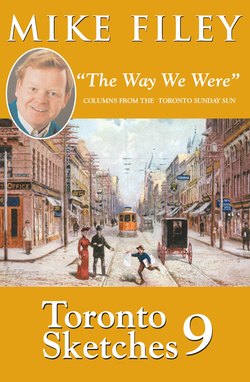Читать книгу Toronto Sketches 9 - Mike Filey - Страница 17
ОглавлениеMa Bell’s Birth
What weighs over five pounds, has 2,096 pages, features a cast of many thousands, and has a plot that’s impossible to follow? Give up? The latest Bell telephone directory appearing on front porches all over town.
There’s quite a contrast between the newest edition and the very first telephone book that was issued in Toronto more than a century ago. Actually, use of the word book to describe that first directory is really a misnomer; it was more like a small booklet. The firm that published it was the fledgling Telephone Despatch Company, a local enterprise that provided a pioneer telephone service in the young city using Alexander Graham Bell’s recently patented invention. The founders of this new company, which had been incorporated in 1878 with a total investment of $3,000, were optician Charles Potter, Dr. A.M. Rosebrough and brother Melville, and Hugh Neilson. The last gentleman, who lived at 321 Carlton Street, served as the manager of the nascent organization. The company operated on a 24-hour basis and had a total of three employees.
Its first “List of Subscribers” was issued on May 1, 1879, and was printed by Bingham and Taylor, Leader Lane (the small street that still exists on the east side of the King Edward Hotel). This document was, in fact, a three-inch-by-five-inch, four-page cardboard folder containing the names of its 56 customers, a number that included the four founders. Some of the other Toronto businesses that tried out the new service were commission merchants Chapman and Sons, 91 Front Street East; druggist H.J. Rose, whose store was at the Yonge and Queen intersection; Robert Walker’s dry goods store at 35 King Street East (site of today’s King Edward Hotel); the offices of the Globe and Telegram newspapers; the St. Charles Restaurant on lower Yonge Street; and a couple of railway offices (specifically, the Grand Trunk and the Union Pacific). The very first commercial contract was signed between the Toronto Telephone Despatch Company and Messrs. McGaw and Winnett, proprietors of the province’s busiest hotel, the Queen’s, a rambling structure that stood where the Royal York Hotel is located today.
The Queen’s Hotel on Front Street West had Toronto’s first commercial telephone.
The first “private” telephone line connected Oliver Mowat’s law office on Church Court with the premier’s office in the old Parliament Buildings (above) on Front Street, west of Simcoe. (Photo: Ontario Archives)
The majority of these early subscribers were connected via party lines, with six to eight customers on each circuit. No doubt an annoyance, but one that would eventually be phased out once technology caught up with the dreams of the young telephone company.
The first private line connected Oliver Mowat’s law office at 24 Church Court with his office in the Parliament Buildings on the north side of Front, just west of Simcoe. The telephone must have been a welcome addition for the very busy Mowat who, as a Father of Confederation, had helped create a new Dominion some years earlier and now served as Ontario’s premier and attorney general while still practising law.
The Despatch Company’s “List of Subscribers” included the names and addresses of the 56 subscribers, but there were no phone numbers yet, the connection being done manually through an operator at a switchboard. The list also included the protocol to be followed when making or receiving a call: “To converse with subscribers call the Central Office, tell them whom you wish to converse with; as soon as the person desired has answered the operator will connect the two circuits and say ‘All Right.’ Then the person who called should commence the conversation while the other listens. In each case allow the person calling you to commence the conversation, first giving the subscriber’s name. Speak slowly and distinctly, with some force, but not in a high voice; and let the telephone rest against the upper lip. At all times give your hearers time to transfer the telephone to their ear before you speak and be certain a sentence is finished before you reply.”
In those far-off days one could not talk and listen at the same time. It was a one-way conversation.
In April 1881 the newly organized Bell Telephone Company of Canada absorbed the pioneer firm and kept Neilson as the manager who ran things in the new Bell office at 10 King Street East.
As more and more people opted for a telephone, the manual system became obsolete and exchanges were introduced. First came MAin, followed by others such as NOrth, JUnction, and BEach. Callers now had to remember two letters and four numbers when placing calls. The introduction of “automatics” came in July 1924 when GRover became the first “dial” exchange. Others quickly followed: ELgin, HOward, HArgrave, et cetera. In 1951 Bell introduced two-letter, five-number dialling (ELgin 1234 became EMpire-4-1234). A decade later ANC (All-Number Calling) was introduced, and soon all the fondly remembered prefix names were gone, replaced by numbers (EMpire-4-1234 became 364-1234). Recently, the addition of the area code became mandatory, resulting in 10-digit numbers.
March 30, 2003
